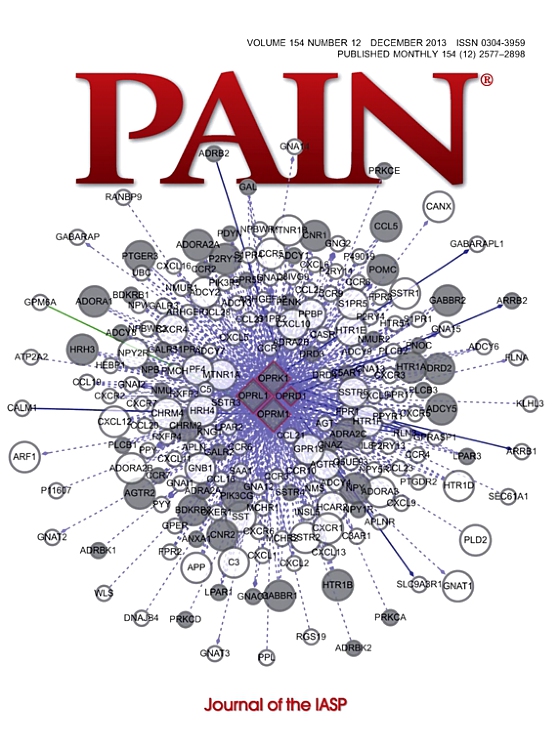糖尿病多发神经病变的神经性疼痛:一项5年前瞻性研究。
IF 5.9
1区 医学
Q1 ANESTHESIOLOGY
引用次数: 0
摘要
目前对糖尿病多发神经病变(P-DPN)神经性疼痛的前瞻性研究较少。我们的目的是研究P-DPN随时间的发展以及与疼痛的发展和缓解相关的因素。在这项为期5年的随访研究中,根据多伦多共识标准,我们从2016年至2018年期间丹麦全国5514名新诊断为2型糖尿病的患者中招募了102名基线时至少可能患有DPN的患者。所有参与者都接受了DPN和疼痛的详细表型分析,包括床边感觉检查、定量感觉测试(QST)、皮肤活检以及基线和随访时的神经传导研究。至少可能P-DPN的估计患病率(95% CI)从11.5% (8.2;14.9)至14.8% (9.2;随访时20.4),糖尿病病程中位数(四分位数范围)为11.0(9.2,12.2)年。在64例基线无痛性DPN患者中,38.2%的患者在随访时出现疼痛,而38例基线P-DPN患者中28.9%的患者在随访时没有疼痛。基线感觉不良的患者发生疼痛的比例(42.9%)高于无感觉不良的患者(27.9%,Χ2-test趋势:P < 0.0001)。疼痛的发生与女性、对QST温暖刺激的基线敏感性较低以及腓肠感觉神经动作电位基线较低有关。疼痛的缓解与较低的基线体重指数和胆固醇有关,以及对基线时QST的冷、机械和振动刺激的敏感性较高。这项详细的研究确定了神经性疼痛发展和停止的危险因素。本文章由计算机程序翻译,如有差异,请以英文原文为准。
Neuropathic pain in diabetic polyneuropathy: a 5-year prospective study.
There are few prospective studies on neuropathic pain in diabetic polyneuropathy (P-DPN). We aimed to examine the development of P-DPN over time as well as factors associated with both the development of and relief from pain. In this 5-year follow-up study, we included 102 patients with at least probable DPN at baseline, according to the Toronto consensus criteria, recruited from a nationwide Danish cohort of 5514 patients with newly diagnosed type 2 diabetes between 2016 and 2018. All participants underwent detailed phenotyping of both DPN and pain, consisting of a bedside sensory examination, quantitative sensory testing (QST), skin biopsies, and nerve conduction studies at baseline and follow-up. The estimated prevalence (95% CI) of at least probable P-DPN increased from 11.5% (8.2; 14.9) at baseline to 14.8% (9.2; 20.4) at follow-up, with a median (interquartile range) diabetes duration of 11.0 (9.2, 12.2) years. Among 64 patients with baseline nonpainful DPN, 38.2% developed pain at follow-up, while 28.9% of 38 patients with baseline P-DPN did not have pain at follow-up. A higher proportion of patients with baseline dysesthesia developed pain (42.9%), compared with patients without dysesthesia (27.9%, Χ2-test for trend: P < 0.0001). Development of pain was associated with female sex, lower baseline sensitivity to warm stimuli on QST, and lower baseline sural sensory nerve action potential amplitudes. Relief from pain was associated with lower baseline body mass index and cholesterol, as well as higher sensitivity to cold, mechanical, and vibratory stimuli on QST at baseline. This detailed study identified risk factors for neuropathic pain development and cessation.
求助全文
通过发布文献求助,成功后即可免费获取论文全文。
去求助
来源期刊

PAIN®
医学-临床神经学
CiteScore
12.50
自引率
8.10%
发文量
242
审稿时长
9 months
期刊介绍:
PAIN® is the official publication of the International Association for the Study of Pain and publishes original research on the nature,mechanisms and treatment of pain.PAIN® provides a forum for the dissemination of research in the basic and clinical sciences of multidisciplinary interest.
 求助内容:
求助内容: 应助结果提醒方式:
应助结果提醒方式:


